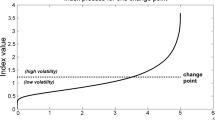Abstract
Contrary to the common sense in economics and financial engineering, price fluctuations at very fine level of motion exhibit various evidences against the efficient market hypothesis. We attempt to investigate this issue by studying extensive amount of foreign currency exchange data for over five years at the finest level of resolution. We specifically focus on the proposed stability in binomial conditional probabilities originally found in much smaller examples of financial time series. In order to handle very large data, we have written an efficient program in C that automatically generates those conditional probabilities. It is found that the stability is maintained for extremely large time duration that covers almost the entire period. Based on the length of conditions for which the conditional probabilities are distinguishable each other, we identify the length of memory being less than 3 movements.
Similar content being viewed by others
References
Bachelier, L. (1900). Théorie de la speculation. Doctor Thesis,Annales Scientifiques de l’Ecole Normale Sperieure,III-17, 21–86 (Translation: Cootner, P. H. (ed) (1964). The Random character of stock market prices, 17–18, MIT Press, Cambridge, Massachusetts).
CQG (2001). A set of tick data foreign currency exchange rates of Japanese Yen vs. U.S. Dollar, taken from CQG-terminal from 1995 to 2001 by H. Moriya. CQG is a chart-graphics distribution company (http://www.cqg.com/).
Fama, E. F. (1991). Efficient capital market II,Journal. of Finance,46, 1575–1617, and the references therein.
Ghashghaie, S., Breymann, W., Peinke, J., Talkner, P. and Dodge, Y. (1996). Turbulent cascades in foreign exchange markets,Nature,381, 767–770.
HFDF (1993). A set of tick data from October 1, 1992 to September 30, 1993, obtained from Olsen & Associates at http://www.olsendata.com/
Mandelbrot, B. B. (1963). The variation of certain speculative prices,Journal of Business,36, 394–419.
Mantegna, R. N. and Stanley, H. E. (1995). Scaling behavior in the dynamics of an economic index,Nature,376, 46–49.
Moriya, H. (2002). Tick data filtering and cleaning, Talk given at the First ISM/GUAR Economics Meeting, Institute of Mathematical Statistics, July 18–19, 2002: http://www.cs.miyazaki-u.ac.jp/joho2/ mieko/econo_e/ (to appear in SOKENDAI publication, 2003).
NYSE-TAQ (1993). A collection of tick data of all the trades and quotes of stock prices at the NYSE market since 1993, which are available from New York Stock Exchange at http://www.nyse.com/
Ohira, T.et al. (2002). Predictability of currency market exchange,Physica A,308, 368–374.
Rabinier, L. and Huang, B.-H. (1993).Fundamentals of Speech Recognition, Prentice Hall; More general discussions on Markov Models are found, e.g., in Hideki Imai (1986).Information Theory, Shokodo, Tokyo.
Tanaka-Yamawaki, M. (1999). Human generated random numbers and a model of the human brain functions,Proceedings of 1999 IEEE International Conference on Systems, Man & Cybernetics,III, 223–228.
Author information
Authors and Affiliations
About this article
Cite this article
Tanaka-Yamawaki, M. Stability of Markovian structure observed in high frequency foreign exchange data. Ann Inst Stat Math 55, 437–446 (2003). https://doi.org/10.1007/BF02530510
Received:
Revised:
Issue Date:
DOI: https://doi.org/10.1007/BF02530510




